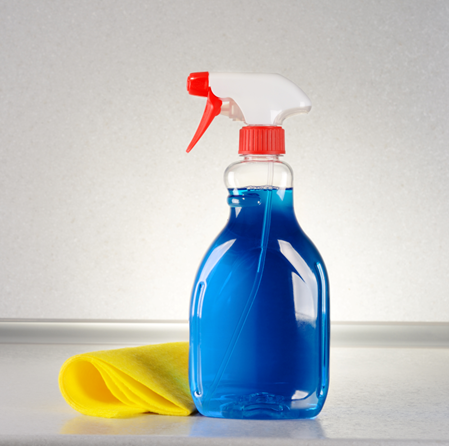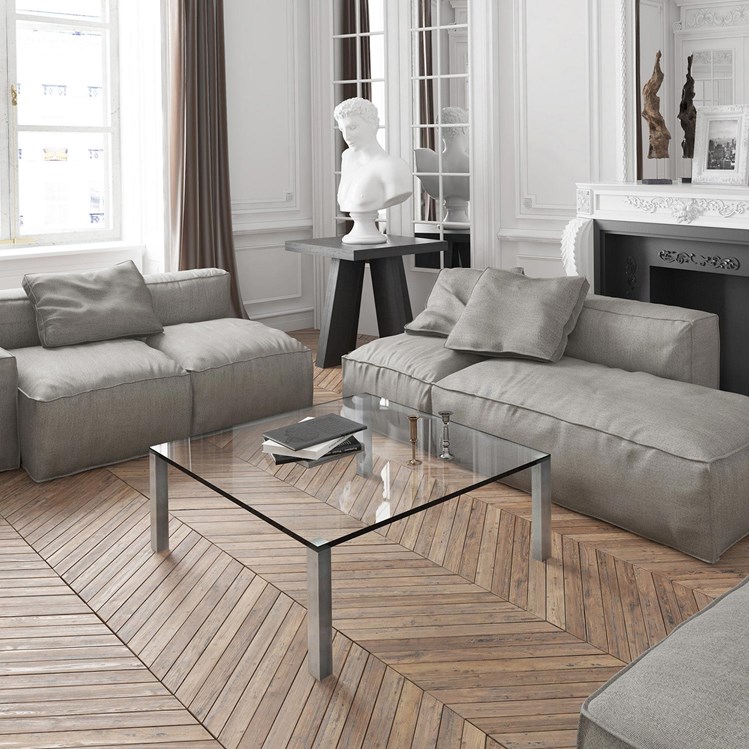-
Free Delivery in DE, AT & CH
-
Made in Germany
-
Individual Customisation Available
Author: DREIECK DESIGN Editorial Team
Last updated: June 21, 2025
Designer glass furniture from DREIECK DESIGN is an elegant eye-catcher, lending a special lightness and sophistication to any room. The brilliant clarity and perfect surfaces are a hallmark of the highest quality. To ensure they continue to delight you and your home for as long as possible, proper care is essential. Although high-quality glass is robust, it requires special and particularly gentle care to prevent scratches, streaks, and dull spots. In this guide, we'll show you how to clean your glass furniture correctly and what to consider for different types of glass and material combinations.

A successful and gentle glass cleaning process begins with selecting the right tools. With just a few high-quality items, you can achieve professional results:
First things first: Never clean glass furniture dry! Even the smallest dust or dirt particles can act like sandpaper on the dry surface and cause fine, irreparable scratches (so-called "cleaning streaks"). Therefore, always proceed as follows:

(Regular care maintains the shine of high-quality furniture like the QUADRO coffee table)
Not all glass is the same. Depending on the surface finish, an adapted cleaning method is required.
An insider tip for removing particularly stubborn dirt, such as dried-on stains or limescale marks from a robust clear glass surface, is the use of very fine steel wool. This may sound surprising at first, as steel wool is not known for being the gentlest cleaning utensil. However, the right kind of steel wool can be a master at effectively removing coarse dirt from glass without scratching it.
When using steel wool, the same rule of thumb applies as for glass cleaning in general: never clean dry! Put some glass cleaner on the wool to avoid damaging the glass. Also, pay close attention to the grade of the wool: you can safely use grades 000 and, ideally, 0000 for cleaning glass. Never use coarser steel wool!
Important Note: Cleaning with steel wool should only be done on clear, uncoated glass like float or Optiwhite glass. If you own, for example, an elegant coffee table or a high-quality display case made of satinized (frosted), matte, or colored lacquered glass, you should under no circumstances use steel wool or other abrasive cleaners. Due to the slightly roughened (satinized) or refined (lacquered) surface, treatment with steel wool can cause irreparable damage and scratches. For these surfaces, only use soft cloths and mild, non-abrasive cleaners!
Especially for glass furniture used as dining or coffee tables, it is advisable to use cleaning agents that are as gentle and natural as possible. Aggressive industrial cleaners containing lye, strong acids, or fluoride are often unnecessary and not recommended. Some proven home remedies that are very effective include:
Proper and regular cleaning is particularly important for exclusive designer furniture made of glass to maintain its value and flawless appearance. After all, these pieces are often a conscious investment in quality and design and should therefore provide enjoyment for longer than conventional furniture. Unsightly scratches, cloudiness, and streaks from improper cleaning are often more visible on glass than on any other material.
Such avoidable damage can detract from the brilliant overall appearance of the glass and thus the entire piece of furniture. With careful, gentle cleaning, you can ensure that your noble designer piece from DREIECK DESIGN shines in new splendour for decades to come.

(A well-maintained workspace: FLY desk made of Optiwhite glass with a drawer by DREIECK DESIGN)
Do you already own glass furniture from DREIECK DESIGN and have further questions about proper cleaning or the care of special surfaces? Then please feel free to contact us. We are happy to help you with our expertise.
It is best to use water with a dash of washing-up liquid and a dash of rinse aid as the cleaning agent. Be careful not to use too much detergent as this will leave streaks on the glass. Then dry quickly with a microfiber cloth.
Cloudy glass is often caused by limescale deposits. An effective home remedy to remove these is vinegar. Add a dash of vinegar to the cleaning water and use it to carefully clean the glass surface.
Add a dash of rinse aid to the cleaning water to make the glass shine again.
The absolute most important rule is: Never clean glass furniture dry! Even the smallest dust or dirt particles can act like sandpaper on a dry surface and cause fine, irreparable scratches. Therefore, always use a soft, clean, and slightly damp cloth when cleaning your valuable glass tables or glass display cases.
For very stubborn dirt on clear, uncoated glass, very fine steel wool (grade 0000) can help. Important: Only ever use it when well-moistened with glass cleaner and with very little pressure. Test it on an inconspicuous area first. This method is absolutely unsuitable for more sensitive surfaces like satin or lacquered glass. You can learn more in our detailed guide to cleaning glass.
No, these surfaces require special care. Satin (frosted) and lacquered glass must never be treated with abrasive agents or steel wool, as this would permanently scratch the surface. Use only soft microfiber cloths and very mild, non-abrasive cleaners here. An example of furniture with such surfaces is our SHINE display cases with satin doors.